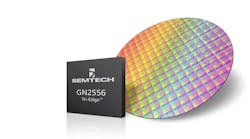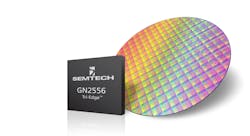The constant growth of the Internet of Things (IoT) and the related Cloud communication infrastructures place a continuous development pressure on the electronic design community. The sheer number of devices and protocols involved demand advanced power methodologies, low comms latency, and multimodal performance to address advanced Edge Computing, artificial intelligence (AI), and Cloud data center networks.
Recently Semtech announced the availability of their GN2558 and GN2559 Tri-Edge CDR SR solutions to enable next-generation data center multi-mode interconnectivity. GN2558 is a quad PAM4 CDR with an integrated VCSEL driver, and GN2559 is a quad PAM4 CDR with an integrated linear transimpedance amplifier (TIA). The chipsets are also fully compliant to the 200G-SR4 Open Eye MSA specification.
To get a deeper insight into the benefits of their new offering, we reached out to Timothy Vang, VP of marketing and applications at Semtech. We talked about the devices and the design ecosystem they address.
EE: So Tim, let's start right up front. So from the point of view of the designer, what does the Tri-Edge offer at the highest level?
Timothy Vang: Good question and thanks for the opportunity. So the Tri-Edge platform is a new way to enable the interconnects inside data centers and eventually wireless infrastructure. So what we're trying to do is enable lower cost, lower power and lower latency so within a data center, and we're seeing a real pull for those kinds of metrics from the end user, the actual hyper-scale data centers, and tier two and tier three data centers for those kinds of capabilities.
They today use an existing solution that does work, but it is at a cost, and that is generally power, latency, and overall chip cost. So we're trying to bring in a new technology that works very well and differentiates itself on some real key metrics that our customers' customers really value.
EE: Excellent. So now, when we talk about these things, 'cause obviously, when you're setting up a facility of any size, you're going to have a lot of planning, a lot of consulting, probably working with your various vendors. You want to have everything dialed in before you start, but then once you start, you have to make sure everything is set up properly. It's all well and good to design the aqueduct, but somebody's got to make sure it's six degrees the whole way.
Timothy Vang: Yeah, that's true. And well, we're kind of lucky in that many of the current platforms within those data centers use our existing ClearEdge platform of chips. And so, we're used to that kind of infrastructure and that needs to be able to deliver in high volume. And where we're going with the Tri-Edge is to try and come in at the next generation of how those interconnects are being deployed.
EE: So when we talk about that whole dialing-in optimization of the solution as it's being deployed, what aid do you offer your clients to optimize, to make that dialing in as painless and optimal as possible?
Timothy Vang: Right. Well, a couple things really matter. One is we work with a lot of the existing suppliers into those data centers. As I mentioned with today's technology, we ship in high volume so we're used to working with those customers who supply the hyper-scale data centers. So we're just basically enabling their next generation of interconnects to serve the hyper-scalers.
But at the same time, we offer complete reference designs for new potential customers who want to get into this platform. And then, we work very closely with the hyper-scale data centers themselves. And in many cases, they have internal kinds of projects where we are cooperating with them and showing them how our chips work and they're seeing it live, these power, cost, latency advantages. So I think it works pretty well cause we hit it at multiple levels.
EE: Right. Now, latelywhenever you're talking about connectivity, security is always an issue that raises its head. Is that something that you don't feel needs to be addressed at the level that you're providing functionality? Or is it the case that there are some people who believe that there's no such thing as security being too granular? Do you offer paranoids or government-oriented type people to get a secure system as secure as they'd like to see?
Timothy Vang: Yeah, it's a great question and it might be fortunate or unfortunate, but our level is basically to provide essentially a straight data path. So we don't deal with the encryption or de-encryption. We basically provide a straight connection from point A to point B. So there can be data encryption that we transport, but we don't offer any of it.
EE: It could get to the point where there's going to be a firewall literally at the transistor gate level almost, when you start talking about this current generation of security microcontrollers, for example, who've got secure boot and secure blocks on the chips. What are your thoughts on that proliferation?
Timothy Vang: Yeah, I completely agree. It's going to be at the supply level, so where they're doing things like forward error correction, they will be adding encryption and then, that will basically have to be transported from one point to the other. And then the FEC at the other end corrects for errors and then the de-encryption has to happen at the other side. But yeah, we're seeing more and more of that and that ends up being part of the standards bodies that we're participating in to make sure that we either enable that or pass the data as needed. So we make sure we're compliant with all standards to make the end customer see this as transparent. Our technology doesn't have to be differentiated in that way.
EE: And that brings us Tim, to our last point, compliance verification. It’s another evaluation engineering aspect of the design process where you’ve got to make sure everything is optimum, all of the key holes line up as it were, right. What are some of the challenges in ensuring that everything is compliant?
Timothy Vang: I think it's broader than you might think. So there are standards bodies that define what a transmit signal has to be and what the receiver has to be able to accommodate to close the link, for example, and so, we have to be compliant with that. We have to inter-operate with the existing chips. And we've been part of a new MSA, so multi-source agreement, where we've combined with a number of other companies, I think close to 40 companies now, that kind of agree with the Tri-Edge principle, which is this new way of kind of providing chips into those interconnects and to save power, cost, latency, as I mentioned before.
We're part of an ecosystem here that we think will provide a real benefit to the end user and based on what your publication, your audience, one of the key aspects of that is to make sure that the testing, the manufacturing tests of these interconnects is efficient and delivers high yield components. And the receive has to be able to meet a certain i-mask. And by having those transmit and receive signals that way, it's very much like today's high-volume manufacturing and test. It works very well. And that's part of what being compliant has to be. It has to not just work in a standards body, but it has to be cost efficient in the manufacturing realm.
EE: Well, then no, and then it's a worthwhile point to bring up, Tim, because when you think of it that way, it's all part and parcel of the development. It's like publishing, people talk about publishing and a lot of people focus on certain aspects, but it's a team effort. If the person who forgot to put the page numbers on or make sure they were in the right order didn't do their job, the whole effort is wasted.
Timothy Vang: Yeah, exactly. So we think we're trying to hit all the marks here to make something that really is beneficial to the end customer.
EE: All right then, Tim, was there anything you wanted to leave with our audience? Anything you want to leave our audience with, something to put into the conclusions?
Timothy Vang: Well, we're very excited about our new Tri-Edge platform as you know. We think it's going to really service the data center market and I think you'll see a lot of content out there. We're promoting that and we're working with actual hyper-scale data centers to test in their systems right now and everything is looking like a go. And we believe this technology will also find other markets, things like wireless front haul and backhaul.
So, we're really excited about the Tri-Edge platform, and we appreciate the opportunity to talk to your audience and hopefully, they can work with us to provide end solutions to the data centers and other customers. So thanks a lot.



